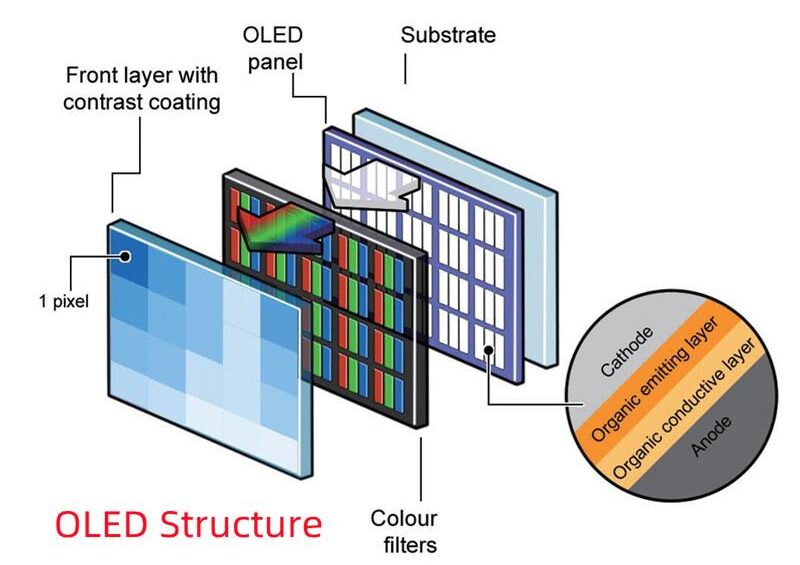Technological Progress Of Mobile Phone LCD Screen and OLED Screen
Mobile phone screens are mainly divided into LCD screens and OLED screens. With the development of OLEDs, we have found that many mobile phones equipped with OLED panels use DC dimming (the dimming method of LCD screens) to avoid damage to the eyes, and More and more mobile phone manufacturers are equipped with eye protection mode for their mobile phones. This makes us think that it is necessary to discuss the new technologies and developments of LCD and OLED screens currently on the market, so that consumers can reasonably choose the LCD screen mobile phone or OLED screen mobile phone that suits them.
 As we all know, LCD screens need to be illuminated by a backlight to display. The principle is based on the fact that white light passes through color filters to produce different colors, and the pass rate of each pixel is controlled by electric current to control the color of the pixel. The OLED screen uses an organic self-luminous material, which does not require a separate backlight or color filter. Each pixel in the OLED panel can be assigned three colors of red, green, and blue, which can be displayed according to the needs of the screen.
As we all know, LCD screens need to be illuminated by a backlight to display. The principle is based on the fact that white light passes through color filters to produce different colors, and the pass rate of each pixel is controlled by electric current to control the color of the pixel. The OLED screen uses an organic self-luminous material, which does not require a separate backlight or color filter. Each pixel in the OLED panel can be assigned three colors of red, green, and blue, which can be displayed according to the needs of the screen.


At present, the most OLED mobile phones adopt COF packaging technology, which can bend the cable to the back of the screen.The COP packaging technology, which is more advanced than COF, can compress the screen module to the greatest extent, and bend the cables and IC chips to the back of the screen. It is the most advanced packaging technology at present. iPhone X and OPPO Find X are the first two models to use this technology. Another packaging technology for mobile phone screens, COB packaging, can directly paste the core components to the substrate, and then use thin metal wires to tightly weld the substrate pads, thus avoiding the process of separate packaging.

 We can see many advantages of OLED screens, but what improvements can OLED screens make when facing defects?
We can see many advantages of OLED screens, but what improvements can OLED screens make when facing defects?
Because each pixel of the OLED screen emits light independently, the working time is different. After a long time of use, some pixels may age prematurely, leaving “after images”, which is also commonly known as screen burn-in. In order to avoid this problem, Samsung actively shifts the pixels that are often displayed on the screen, that is, to shift the fixed pattern by a few pixels after a period of time to prevent the same pixel from working for a long time. Apple, on the other hand, has added code to reduce screen aging in iOS, and cooperates with the automatic brightness function to minimize the possibility of OLED screen burn-in.


About Oriwhiz
Oriwhiz is a mobile phone LCD/OLED screen and other phone spare parts’ manufacturer(factory) which is located in Shenzhen China.We are cell phone display wholesaler(Chinese supplier), offer OEM and ODM service to customers all over the world. Our products have ISO9001,CE,FCC,ROSH certificate. All of our products are manufactured by brand new materials and 100% quality test before shipping. We promise our best quality products will be delivered to our clients on time. We have professional customer service and welcome inquiry any time. Our main products include: iPhone LCD,iPhone Charging Port,iPhone Front Camera,iPhone Back Camera,iPhone ear speaker,iPhone Battery.etc.Not only iPhone related products,we also have mobile phone parts for Samsung,Huawei,Xiaomi Oppo,Vivo etc.
Article reference:The Difference Between LCD and OLED Screens (and Why It Matters for Your iPhone)
Below are some links:
mobile phone LCD/OLED screen:https://www.oriwhiz.com/
iPhone LCD:https://www.oriwhiz.com/collections/iphone-repair-parts-iphone-screen-lcd-supplier-factory
Samsung:https://www.oriwhiz.com/collections/samsung-repair-parts-mobile-display-wholesaler-phone-lcd-factory
Huawei:https://www.oriwhiz.com/collections/huawei-repair-parts-lcd-display-manufacturer-wholesale-mobile-phone-lcd
The Difference Between LCD and OLED Screens (and Why It Matters for Your iPhone) :https://www.lifehacker.com.au/2021/10/the-difference-between-lcd-and-oled-screens-and-why-it-matters-for-your-iphone/


 We can see many advantages of OLED screens, but what improvements can OLED screens make when facing defects?
We can see many advantages of OLED screens, but what improvements can OLED screens make when facing defects?




